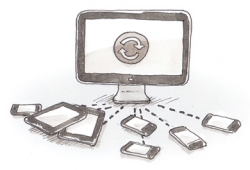Does your mobile phone provide better quality than a typical webcam? I'll test some virtual webcam software for mobile.
Sh*t – it’s that easy? (but my mobile network is not ready)
 In the past weeks, I’ve been busy showing WebRTC to various mobile operator CTO/CIO types. The issue mobile operators are facing is not dissimilar to what the fixed line guys have been mired in for the last years – despite having large profitable businesses, they’re concerned about being rendered irrelevant in this ever changing game.
In the past weeks, I’ve been busy showing WebRTC to various mobile operator CTO/CIO types. The issue mobile operators are facing is not dissimilar to what the fixed line guys have been mired in for the last years – despite having large profitable businesses, they’re concerned about being rendered irrelevant in this ever changing game.
The issue for mobile operators is that their ‘brand’ is only available on your existing GSM/LTE phone and that brand is quite limited. You have an iPhone not a Vodafone. Nor do mobile operators have much real estate on your PC, tablet or any other of the numerous screen types that seem to be reproducing in our lives. Most efforts here have fallen flat.
The desire is pretty simple, how do we enable our customers to make/receive phone calls and messages across any device they may have and for our brand to be recognized. To wit, I use Skype and it works great on my iPhone, desktop and tablet. In fact, I can be logged on all 3 at the same time and with the same the experience and yes, I’m well aware I’m using Skype. This fact hasn’t escaped the mobile operator. But trying to compete with Skype is hard and Skype’s had years of a head start.
I’m doing my demo of a WebRTC ‘phone’ client with all sorts of unique branding. The audience nods politely. Yes you made a phone call from your Chrome browser, how cute. I then switch to show them the underlying source code. A gasp from the audience. And far in the back I hear the CIO mutter, “Shi*t!”
Indeed. With a single chart filled with a bunch of HTML, this CIO immediately grasped the power of WebRTC. I can do something with this using my existing IT staff and it won’t be hard, I have control over what it is and it won’t be expensive or require a building full of servers and staff.
But the devil is always in the details, after investing millions in supposedly future proof IMS, mobile operators are quickly discovering that it’s not so flexible after all. Today’s mobile networks are architect-ed starting with a SIM card (circa 1982) and the entire back office is set-up assuming there is 1 user, 1 device, 1 identity. Unfortunately, we don’t live that way today.
With near 100% penetration of mobile in most modern countries, both Apple and Samsung would love for you to have multiple devices so their business can grow. Perhaps a fancy phone, maybe one for sports or the gym, a big one, a little one, a pretty one — you get the point. But it’s nearly impossible today, the IMS network won’t easily allow it.
Does Apple want you to have multiple iPhones, of course!
The challenge/question/dilemma do the mobile operators figure out how to drag IMS into the jet age (and at what price?) or do they leave the GSM voice network to whatever remaining life it has and endorse WebRTC as an access technology? The timing is especially critical with the prospects of VoLTE now on their minds. Might one imagine your mobile voice being handled by a WebRTC dialer? Not too hard to imagine.